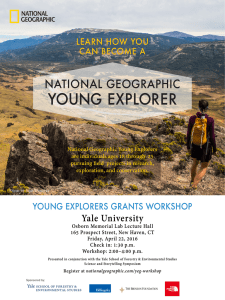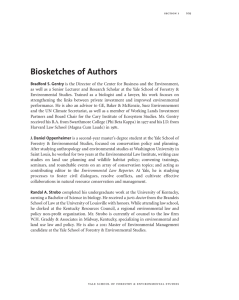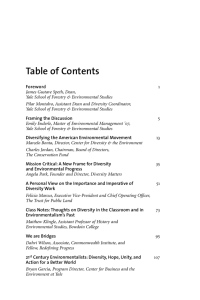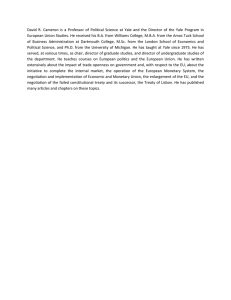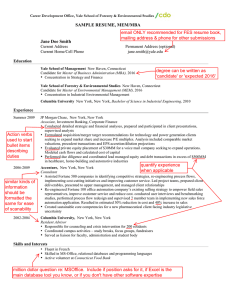Bulletin Series ₉₈
advertisement
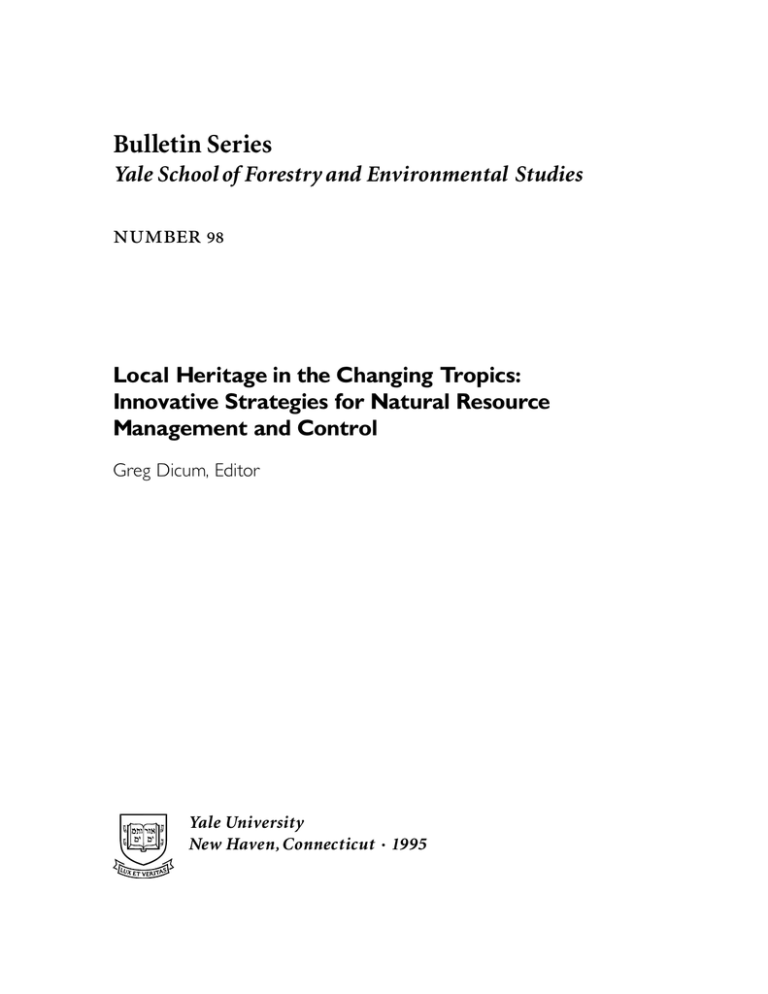
Bulletin Series Yale School of Forestry and Environmental Studies ₉₈ Local Heritage in the Changing Tropics: Innovative Strategies for Natural Resource Management and Control Greg Dicum, Editor Yale University New Haven , Connecticut • 1995 The Yale School of Forestry and Environmental Studies Bulletin Series, begun in 1912, issues faculty and student monographs, symposia and workshop proceedings, and other reports on an occasional basis. To order copies of this or other Yale F&ES Bulletins, contact: Publications Yale School of Forestry and Environmental Studies Sage Hall 205 Prospect Street New Haven CT 06511 USA Volume Editor Greg Dicum Bulletin Editor Joseph Miller Director of Communications Jane Coppock Design R. Richard Solaski Cover The Reconciliation Through Music , by Marina Mendez Cruz of Corazones Valientes Production Yale University MIS Publishing Paper Mohawk Superfine, Softwhite recycled, lb. writing, smooth, acid free Bulletin Number ISSN - CODEN BYSSDM © Yale University Permission is granted to reproduce this volume without prior written consent. Portions of this Bulletin are available on the Internet from the Communications for a Sustainable Future Gopher Server at: csf.colorado.edu / Environment / International Society of Tropical Foresters Contents ACKNOWLEDGMENTS 5 PREFACE 7 FOREWORD 8 INTRODUCTION 9 KEYNOTE ADDRESS Big Conservation and Little Conservation: Collaboration in Managing Global and Local Heritage Janis B. Alcorn 13 SECTION I: LEGAL STRUCTURES AND LOCAL RECOGNITION 31 Community Resources in Borneo: Failure of the Concept of Common Property and its Implications for the Conservation of Forest Resources and the Protection of Indigenous Land Rights George N. Appell 32 George Appell Working Group 53 The Area de Protección de Fauna y Flora Yum Balam: The Initiation and Challenges of a Development Program for the Communities and the Environment in the Maya Zone of Northern Quintana Roo Sebastián Poot Balam 57 Sebastián Poot Working Group 63 The Panará: Indigenous Territory and Environmental Protection in the Amazon Stephan Schwartzman 66 Stephan Schwartzman Working Group 83 Indigenous Politics and “Local Heritage” in the 1990s: Shifting Concepts of Land Use, Land Tenure, and Self Theodore Macdonald 86 Theodore Macdonald Working Group 99 SECTION II: CONSTRUCTIVE MARKET PARTICIPATION 104 The Experience of the Alto Juruá Extractive Reserve with Vegetal Leather: Engaging Forest Product Markets for the Survival of Ecosystems and Cultures Chico Ginú 105 Chico Ginú Working Group 109 Contents Neoliberal Ecopolitics and Indigenous Peoples: The Kayapo, The “Rainforest Harvest,” and The Body Shop Terence Turner 113 Terence Turner Working Group 124 Building Markets for Non-Timber Forest Products: Challenges and a Few Lessons Learned Sharon Flynn 128 Sharon Flynn Working Group 138 Global Trade and the Rainforests: Corporate Growth vs Indigenous Prosperity in Tropical Countries John W. Friede 143 John Friede Working Group 153 SECTION III: INFORMATION TECHNOLOGIES 155 Appropriate Geomatic Technology for Local Earth Observation Peter Poole 156 Peter Poole Working Group 164 The Role of Environmental NGOs in the Changing Tropics: Networking for Community Empowerment Jose Roberto Borges 167 Jose Borges Working Group 174 Knowledge and Information Resources for Local and Traditional Natural Resource Users: Networking and Conferencing Systems, the Internet, Online Services, Libraries, and Information Centers Richard Labelle 176 Richard Labelle Working Group 192 Indigenous Land Use Mapping in Central America Mac Chapin 195 Mac Chapin Working Group 204 Acknowledgments An undertaking of the scale of the 1995 ISTF conference is impossible without the dedication and commitment of numerous competent and hard-working individuals. The three days of the conference itself, in which 150 people came to listen to and to exchange ideas with 13 speakers, was the culmination of a year of hard work on the part of the Conference Committee. Together with the many people who came together to execute the conference weekend, we were able to treat participants from around the world to a very successful and very worthwhile gathering. Those primarily responsible for this success are listed below — each one’s contribution was vital in its own way, and each, we hope, came away from this experience enriched. SPONSORS The Tropical Resources Institute and The Dean’s Office at the Yale School of Forestry and Environmental Studies The Weyerhaeuser Center for Forest Resource Management and Policy Studies at Yale F&ES The International Society of Tropical Foresters The Society of American Foresters, Yale Student Chapter Déjà Shoe Corazones Valientes FACULTY ADVISORS Dr. Mark S. Ashton, Assistant Professor of Silviculture, Yale School of Forestry and Environmental Studies Dr. Joseph A. Miller, Lecturer in Forest History, Yale School of Forestry and Environmental Studies CONFERENCE ORGANIZING COMMITTEE Karen Beard, Rachel Byard, Ronald Cherry, Greg Dicum, Gary Dunning, Andreas Eicher, Cesar Flores, Derek Halberg, Chris Hopkins, Andrea Kivi, Lydia Olander, Richard Payne, Cathryn Poff, Walter Salazar, Robin Sears, Austin Troy, Sudha Vasan CONFERENCE ASSISTANTS Dwight Barry, David Casagrande, Andy Cooper, Bret Elderd, Ayesha Ercelawn, Bryan Foster, Patricia Garffer, Wendy Gerlitz, Kasia Grisso, Marie Gunning, Emily Harwell, James Jiler, Sharon Katz, Andi Lee, Kyle Lonergan, Elizabeth Malek-Zadeh, Paul Maykish, Megan McGroddy, Jai Mehta, Hans Overgaard, Astrid Palmieri, Susanne Pelletier, Jennifer Pett-Ridge, Paige Rausser, Karalyn Replogle, Shigeo Sakai, Jonathan Scheuer, Janet Sturgeon, Ricardo Tarifa, Matthew Udziela, Ted Wickwire, Rhonda Williams, Peter Wilshusen SUPPORT THROUGHOUT Jake Kosek, Nina Luttinger, Jim Spencer, Chris Woodward ADMINISTRATIVE SUPPORT Jane Coppock, Christina Cromley, Carolyn Falls, Ada Foley, Lucinda Gall Preface It was with great pleasure that I welcomed the participants to the Conference on “Local Heritage in the Changing Tropics,” as I do now the readers of these proceedings. The conference and the proceedings are products of our School, and they exemplify our mission and our commitment to pursuing it. The theme and composition of the conference are explicitly interdisciplinary, reflecting the central theme of the Yale School of Forestry and Environmental Studies. Today’s natural resource challenges demand an interdisciplinary approach. A full understanding of the issues can be derived only through an exploration of the ecological, socio-economic, political and cultural dimensions of the problem. In our School, we view natural resource problems as human problems. Our students are trained that way, giving them the interdisciplinary framework for professional effectiveness. “Local Heritage in the Changing Tropics” is the most recent in a series of conferences organized by our student chapter of the ISTF. This series represents a highly valued tradition, in which our students develop the conference’s theme, identify and engage speakers, make all arrangements, raise funds, hold the conference and help produce the proceedings. The students do everything with no more than seed funding and cheerleading from the faculty. The results underscore the quality, professionalism and enthusiasm of our excellent students. I warmly congratulate them on a job very well done. These proceedings are being published as part of the School’s renewed Bulletin series, which has recorded and disseminated projects of special interest generated by faculty or students in the School on an occasional basis for nearly a century. I am pleased to note the reactivation of the series, which is a particularly appropriate outlet for these proceedings. Jared L. Cohon, Dean Yale School of Forestry and Environmental Studies Foreword I was directed by the President of the International Society of Tropical Foresters, Dr. Warren Doolittle, to let the ISTF Student Chapter Members know that we appreciate the work that goes into the several activities that have been accomplished by the Yale Chapter. The recent conferences, including the conference on Timber Certification held last year and this conference on Local Heritage, are areas that need discussion and are fora to help industry, environmental groups, and government employees more fully understand the issues and activities taking place in tropical forests. We compliment the Yale Student Chapter for undertaking and carrying out these activities. RECENT ACTIVITIES OF THE ISTF We have invested in computer capability to help keep membership records more current and to help us lower the costs of publishing the three versions of the ISTF News. We are developing a new consultants roster for ISTF members. ISTF had this service for members several years ago; however, it became too cumbersome to maintain the records by hand. The computer capability will allow us to maintain the roster and make rapid searches when requests for consultants are received. Late last year ISTF and SAF entered into an agreement with the United Nations Food and Agriculture Organization (FAO) to establish a center in Bethesda, Maryland to print and distribute FAO’s Forests, Trees, and People Project (FTPP) Newsletter in North America and the English-speaking portion of the Caribbean. The center is called NACARCE — North American and Caribbean Regional Center, English. Another big undertaking is the Secretariat responsibilities for the International Union of Societies of Foresters (IUSF). This Secretariat was transferred to the United States from Australia. It will be located at the Society of American Foresters (SAF) headquarters for the next five years. ISTF is deeply involved with this activity along with SAF. You may know that one of your professors — Dr. John Gordon — was elected President of IUSF at the world meeting held in Anchorage, Alaska last September. The organization is made up of Forestry Society members from around the world. We at ISTF hope this conference will set the stage for integration of information developed into future tropical forest management discussions. Rodney F. Young ISTF Volunteer Introduction Tropical ecosystems are today burdened by human activity as never before. Centuries of accelerating exploitation have led to the current situation in which natural areas shrink daily in the face of changing human populations, shifting political structures, and increasing resource use. As these areas are consumed by uncontrolled change, so too are destroyed cultures and resource use practices that have often been in place for millennia. In recent years, international concern has mounted in response to the destruction of cultures and associated natural resource use systems at the economic frontier between the global economy and traditional societies. Local peoples’ groups have forged new alliances amongst themselves and with global partners to assert customary resource control. Constructive alternatives to the victimization of market newcomers as well as the amelioration of long standing inequities faced by “traditional” resource users are being developed in diverse settings by indigenous groups, labor organizations, nongovernmental organizations (NGOs), research institutions, governments, and other entities. In February 1995, the Yale F&ES Student Chapter of the International Society of Tropical Foresters brought together 150 students, professionals, community leaders, and academics from diverse fields related to tropical natural resource use and rights for a conference entitled “Local Heritage in the Changing Tropics: Innovative Strategies for Natural Resource Management and Control.” By drawing conference speakers and participants from all levels of this process and from all parts of the globe, we hoped to chart a broad vision for the future of our biological and cultural heritage and to foster communication among workers from various fields and regions. The conference provided an opportunity for speakers to share their work with others, and the working groups that followed each presentation provided a forum for a lively and constructive exploration of the issues. Though each participant brought a different set of viewpoints and experiences to these meetings, several overarching themes emerged. During the course of the weekend, many grappled with trying to come up with an operational definition of “Local.” It was, and remains, a problematic word because we were using it as a euphemism: when we said “Local,” we were often speaking of spatially small communities — of remote villages held together by tight familial, cultural, and occupational ties. Nevertheless, it was not readily apparent what constitutes “Localness.” As the weekend progressed, it became clear that “Localness” is not merely an issue of spatial scale. We often spoke of “Indigenous” groups, but in the context of tropical natural resource users, this too tells only half the story. Throughout the weekend, we had been discussing issues of space. We quickly went beyond physical space to examine political, cultural, economic, institutional, and even cyber spaces. The parts of these various species of space that we were interested in were the edges: the frontiers or borders. This is obvious in the case of the auto-lideración in Venezuela that Peter Poole is assisting — but it is equally the case in, for example, the defense of market spaces against multinationals pushing their way in under the WTO that John Friede chronicles. In every presentation, the collective discourse concerned the demarcation and defense of the space (in all senses) that is today inhabited by some of the last remaining guilds of people directly and immediately connected to their resource bases. This of course begs the question: why are these frontiers threatened? The answer is that since the maturation of industrial culture, there has been a steady increase in the space demanded and held exclusively by this culture. This has always been at the expense of those who do not have the industrial wedge driven between them and their environment. It has been an inexorable process, and the activities that we discussed all seek to moderate the process of the growth of industrial culture. I use the word “moderate” rather than “stop” because much of what we discussed concerned helping groups occupy spaces in terms that industrial culture will respect — essentially such projects bring groups inside industrial space, but on their own terms. Examples include George Appell’s cogent critique of the common property concept, Sharon Flynn’s rigorous marketing approach, Peter Poole’s geomatic work, and, in particular, Mac Chapin’s mapping projects, which translate information into codes understood and accepted by industrial culture. By adopting roles of advocacy or proactive outreach to those on the other side of the econotone, these people are helping to mitigate situations that have, traditionally, ended in what can only be described as crimes against humanity. As inextricable members of industrial culture, doing nothing is complicity. This defense of space — these border wars — are everywhere, and exist in all sorts of different spaces. When we discussed “Localness,” we were talking about spaces, physical and figurative, that have not been wholly consumed by industrial culture. An encouraging new trend was evident throughout the conference weekend. In cases where Indigenous and other local groups are able to assert political power, they are moving into a position to contract advisory services from outside experts — having occupied their space they are now dealing with what to do with it. This was exemplified by Chico Ginú’s initiatives with the Alto Juruá Extractive Reserve as well Sebastián Poot’s experience with the Yum Balam By adopting roles of advocacy or proactive outreach to those on the other side of the econotone, these people are helping to mitigate situations that have, traditionally, ended in what can only be described as crimes against humanity. Protected Area, both of which represent the fruition of this phenomenon. And it is ongoing. As Steve Schwartzman relates, the Panará are now beginning to move into this phase, and, as Ted Macdonald explains, indigenous groups in the Ecuadorian Amazon have been moving toward it for some time. Nevertheless, George Appell reminds us, this development is largely limited to Latin America and the self-determination of marginalized peoples around the world remains a struggle for survival. Another important theme that emerged from the discussions was the crucial role played by knowledge and information. While the endemic knowledge of many groups is clearly comprehensive and important, they are often ill-equipped to interact with entities from industrial culture because of a lack of information about this realm. This theme came up frequently, and was a major component of the discussions led by Terry Turner, Beto Borges, and Richard Labelle. Providing such information-based services can help to make dealing as equals a reality for marginalized groups while at the same time making available the resources for informed self-determination. As Sebastián Poot pointed out, this sort of information and technical assistance is a crucial ingredient in the political legitimization of traditional natural resource management regimes. Although it is true that I found out about Richard Labelle’s work by surfing the Internet, his point that Computer Mediated Communications are simply a tool was an excellent one — the communications I had with him were qualitatively the same as my inviting Sharon Flynn to this conference while we were in the back of a bouncing pickup truck in the Petén. Networking and communication is what makes a community. We can see this clearly in Beto Borges’ work in Brazil, and, even, in the activities that took place in New Haven during the conference weekend. We were, and continue to be, operating as a community. Throughout the weekend, the discussion returned again and again to the tension between “Little” and “Big” Conservation broached by Janis Alcorn in the keynote address. The many examples of dedicated and participatory work brought forth during the conference demonstrated that this tension need not be the undoing of the promising partnership between indigenous knowledge systems and western notions of natural resource “conservation.” By helping marginalized natural resource users to gain control of their natural heritage, we are helping to make the world a livable place for all of humanity. These proceedings are organized along the same lines as the conference weekend itself. Following this introductory section, which includes the keynote address, the text is divided into three By helping marginalized natural resource users to gain control of their natural heritage, we are helping to make the world a livable place. thematic sections. Section I deals with problems in codifying traditional land and resource rights into national law and the concomitant problems in transforming ill-defined “groups” into legal entities. Section II examines market participation as a means to exercise local control of natural resources by constructively channelling market penetration toward goals of improved standards of living, political empowerment, cultural preservation, and the conservation of biodiversity. Section III explores ways that marginalized people are using geomatic and communication technologies to press claims and to conserve customary knowledge. It is our hope that the readers of these Proceedings will find them informative and useful and that, in some way, our collective endeavor will contribute to a humane and sustainable future. Greg Dicum, Editor New Haven, Connecticut
